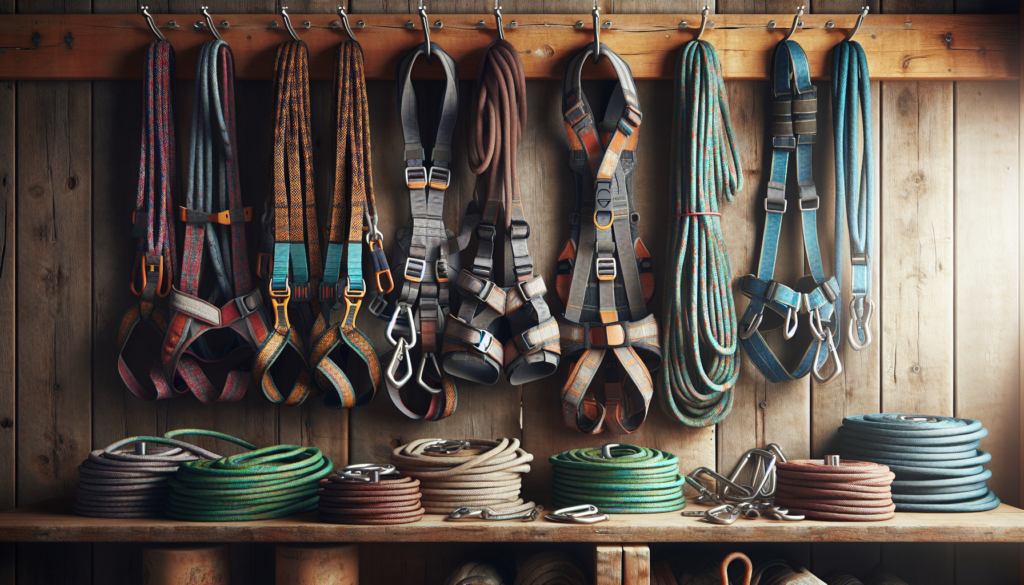The Comprehensive Guide to Climbing Harnesses
When it comes to rock climbing, safety is paramount. One of the most essential pieces of equipment for any climber is the climbing harness. This crucial gear provides support, protection, and security while navigating vertical terrains. Whether you are a seasoned climber or a beginner looking to explore the world of climbing, understanding the ins and outs of climbing harnesses is essential for a safe and enjoyable experience.
Introduction to Climbing Harnesses
Climbing harnesses are specially designed belts with leg loops that are worn to secure a climber to a rope. They distribute the weight of the climber evenly, preventing falls and providing stability during climbs. Harnesses come in a variety of styles, each tailored to different types of climbing activities such as sport climbing, trad climbing, alpine climbing, or indoor climbing.
Imagine hanging hundreds of feet off the ground, relying solely on a piece of equipment to keep you safe. The stakes are high, and the margin for error is slim. Climbing harnesses have evolved over the years, incorporating advanced materials and technology to ensure maximum safety and comfort for climbers.
But what makes a climbing harness so crucial in the world of climbing? How do you choose the right harness for your specific needs? In this comprehensive guide, we will delve deep into the world of climbing harnesses, exploring their history, design, types, and importance in the realm of climbing.
The Evolution of Climbing Harnesses
Historically, climbing harnesses have come a long way from their rudimentary beginnings. In the early days of climbing, climbers would fashion makeshift harnesses out of webbing or rope, often leading to uncomfortable and unsafe climbing experiences. The introduction of the sit harness revolutionized the world of climbing, providing a more secure and comfortable means of support for climbers.
Today, climbing harnesses are made from durable materials such as nylon, polyester, and Dyneema, offering a high level of strength and abrasion resistance. They feature adjustable waist belts and leg loops, padded waistbands for comfort, and gear loops for carrying essential climbing equipment. Modern climbing harnesses are designed to be lightweight, breathable, and versatile, catering to the diverse needs of climbers across different disciplines.
Types of Climbing Harnesses
There are various types of climbing harnesses available on the market, each designed for specific styles of climbing. The two main categories of climbing harnesses are sit harnesses and full-body harnesses.
Sit Harnesses
Sit harnesses are the most common type of climbing harnesses used by climbers. They consist of a waist belt and two leg loops connected by a belay loop at the front. Sit harnesses are ideal for sport climbing, trad climbing, and indoor climbing, providing ample support and comfort for the climber. They are easy to put on and take off, making them a popular choice among climbers of all levels.

Full-Body Harnesses
Full-body harnesses are designed for specific types of climbing activities such as mountaineering, alpine climbing, and rescue operations. These harnesses feature additional straps that go over the shoulders and around the chest, providing extra support and security for the climber. Full-body harnesses are essential for activities where the risk of falling is higher, requiring a more robust harness design to withstand the forces involved.

Specialized Climbing Harnesses
In addition to sit harnesses and full-body harnesses, there are specialized climbing harnesses tailored to specific activities such as ice climbing, big wall climbing, and speed climbing. These harnesses are designed with unique features to enhance performance and safety in challenging climbing environments. They may include ice clipper slots, haul loops, and adjustable leg loops for added versatility and functionality.
Choosing the Right Climbing Harness
When it comes to selecting a climbing harness, there are several factors to consider to ensure you choose the right one for your needs. The fit, comfort, features, and intended use of the harness play a crucial role in determining which harness is best suited for you.
First and foremost, the fit of the harness is paramount. A well-fitting harness should be snug but not constricting, providing support without restricting movement. It should sit comfortably on your waist and thighs, with no excess material or gaps that could lead to discomfort or chafing during climbs.
Comfort is another essential factor to consider when choosing a climbing harness. Look for harnesses with padded waistbands and leg loops, breathable materials, and adjustable straps for a customized fit. Comfort is key, especially during long climbing sessions where you will be hanging in the harness for extended periods.
Consider the features of the harness and how they align with your climbing style. Look for gear loops, haul loops, ice clipper slots, and adjustable leg loops based on the requirements of your climbing activities. The right features can enhance your performance and efficiency on the wall, making your climbing experience more enjoyable and safe.
Lastly, consider the intended use of the harness when making your decision. Are you primarily a sport climber, trad climber, or alpine climber? Do you engage in multiple climbing disciplines and need a versatile harness that can adapt to different scenarios? Understanding your specific needs and preferences will help you narrow down your options and choose the perfect climbing harness for your adventures.
Maintaining and Inspecting Your Climbing Harness
Once you have chosen the right climbing harness for your needs, it is essential to properly maintain and inspect it to ensure its safety and longevity. Regularly inspect the harness for signs of wear and tear, such as frayed webbing, worn stitching, or damaged buckles. Replace any damaged or worn parts immediately to prevent compromising the integrity of the harness.
Clean your harness regularly to remove dirt, sweat, and debris that can weaken the materials over time. Use mild soap and water to gently clean the harness, avoiding harsh chemicals or abrasive cleaners that could damage the fabric. Allow the harness to air dry completely before storing it in a cool, dry place away from direct sunlight and moisture.
Store your climbing harness properly when not in use to prevent damage and prolong its lifespan. Avoid storing the harness in extreme temperatures or humid environments, as this can weaken the materials and compromise the safety of the harness. Hang the harness in a cool, dry place or lay it flat in a gear bag to protect it from dust and debris.
Expert Opinions on Climbing Harnesses
We spoke to renowned climber and gear expert, Alex Honnold, to get his insights on the importance of climbing harnesses in the world of climbing. According to Honnold, “A reliable climbing harness is your lifeline when you’re hanging off a cliff. It’s essential to choose a harness that fits well, feels comfortable, and provides the necessary support for your climbing style.”
He emphasizes the significance of choosing the right harness for your specific needs, highlighting the importance of comfort, fit, and functionality in ensuring a safe and enjoyable climbing experience. Honnold’s expert opinion underscores the critical role that climbing harnesses play in the world of climbing, serving as a fundamental piece of equipment for climbers of all levels.
Common Misconceptions About Climbing Harnesses
There are several misconceptions surrounding climbing harnesses that can lead to confusion and misinformation among climbers. One common misconception is that all climbing harnesses are the same and can be used interchangeably for different climbing activities. In reality, each harness is designed for specific uses and may not be suitable for all types of climbing.
Another misconception is that a climbing harness is unnecessary for indoor climbing or top-rope climbing. While the risks may be lower in these scenarios compared to lead climbing or trad climbing, a climbing harness is still essential for safety and protection. Accidents can happen in any climbing situation, making a harness a crucial piece of equipment for all climbers.
Conclusion
In conclusion, climbing harnesses are a vital piece of equipment for climbers of all levels and disciplines. From their humble beginnings to the advanced designs available today, climbing harnesses have played a crucial role in ensuring the safety and security of climbers around the world. By understanding the history, evolution, types, and importance of climbing harnesses, climbers can make informed decisions when choosing the right harness for their adventures.
Remember to prioritize fit, comfort, features, and intended use when selecting a climbing harness. Regularly inspect and maintain your harness to ensure its safety and longevity. Expert opinions and common misconceptions can provide valuable insights into the world of climbing harnesses, helping climbers make informed decisions and stay safe on their climbing journeys.
Whether you are scaling towering cliffs or navigating indoor climbing walls, a reliable climbing harness is your lifeline in the vertical world. Choose wisely, climb safely, and enjoy the thrill of reaching new heights with confidence and security.

